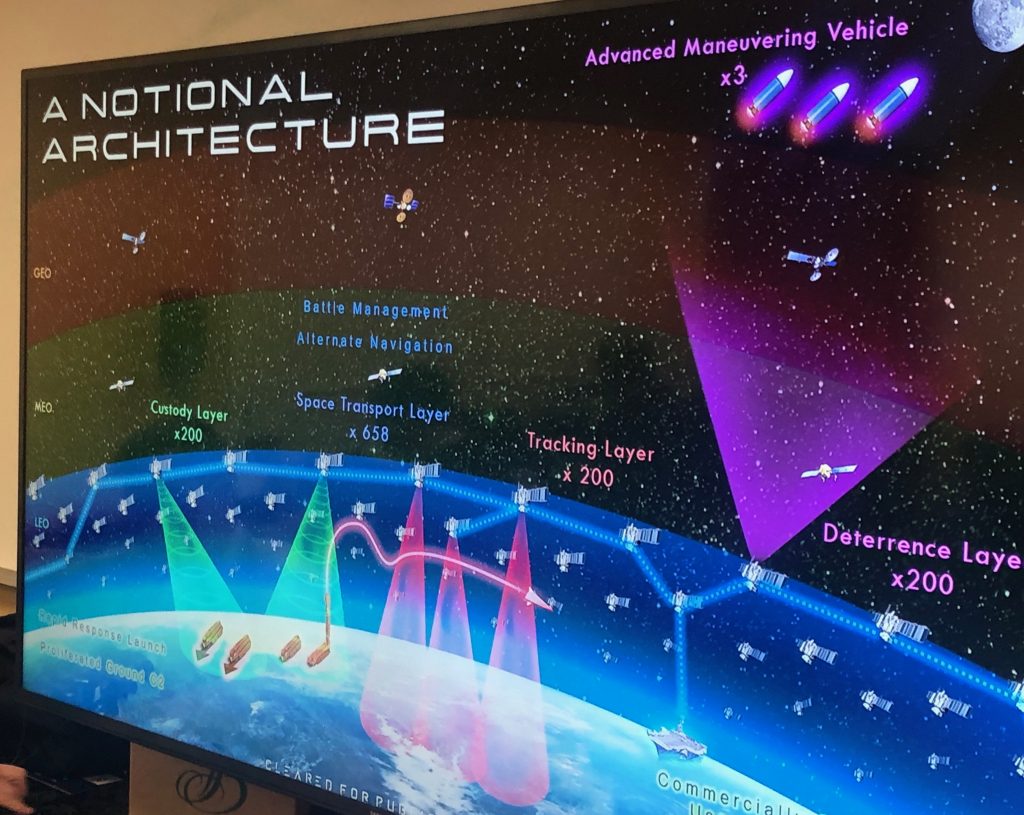
Space Defense Agency “Notional” Space Architecture Reaches For The Moon
WASHINGTON: Fred Kennedy, the energetic new chief of the Pentagon’s fledgling Space Development Agency (SDA), is boldly advocating to take routine U.S. military space operations where they have never gone before: to cislunar space. “Defense follows where commercial goes,” he told me in a phone interview today, echoing the old aphorism of ‘flag follows trade.’
As commercial activities (such as resource extraction) expand outward from Earth to the Moon, he explained, there will be “a need for the equivalent to a Navy or Air Force” to protect that region of space. “We haven’t specifically been told to go worry from GEO to the Moon” he said, “but we know emerging threats will drive us there.”
Indeed, threats, not requirements, are what Kennedy — who told reporters at last week’s Space Symposium that he considers himself the “space architect” at the Pentagon — insists are driving SDA’s goal of up-ending the current national security space architecture.
The “issue of being threat-driven versus requirements-driven is an important one for SDA,” Kennedy says, because it means the agency “intends to rapidly develop responses to threats that we can anticipate now, [threats] that could take existing organizations years or maybe decades to acquire a custom solution for.” While filling gaps in the current architecture and developing assets that can provide augmentation of/alternatives to today’s space systems are missions for SDA, it is the forward-looking role that is fundamental to the new agency’s position in the space acquisition ecosystem. “We expect SDA to be different than those extant organizations,” he told me. “I don’t want to do their jobs.” (Kennedy’s views on how SDA will fill gaps in the current architecture and mesh with other acquisition entities, especially the Air Force’s Space and Missile Systems Center (SMC), are succinctly laid out by colleague Valerie Insinna of Defense News in her post Symposium story.)
Specifically, Kennedy’s “notional architecture” (he calls it Version 0.0) for the future envisions a “deterrence layer” of some 200 satellites based in “high LEO (Low Earth Orbit)” or “low MEO (Medium Earth Orbit)” equipped with optical sensors “looking out” toward the Moon to “provide real-time custody of objects” in cislunar space. These would essentially serve a space situational awareness (SSA) function for the U.S. military in that vast region of space.
Kennedy explained to me that, eventually, this sensor layer could provide space traffic management (STM) functions for operators in the region. It also could relay data to the minimum of three so-called “Advanced Maneuvering Vehicles (AMVs)” the notional architecture envisions for providing the U.S. military with access to and rapid transit between the Earth and the Moon in order to “deliver effects” — as Kennedy put it in his presentation to Space Symposium.
“Effects” is military jargon for being able to accomplish a wide variety of tasks “from blowing stuff up to delivering candy to kids,” explained Secure World Foundation’s technical adviser Brian Weeden, so my obvious question for Kennedy was: are we talking about deploying weapons in cislunar space? “I wouldn’t want to rule it out, but neither do I have any plans for that,” he said, stressing that the AMV’s right now are “very conceptual.”
He explained that the 60-day, multi-stakeholder study SDA undertook to develop the notional architecture did not “prescribe a specific set of missions beyond the need to reach beyond GEO and move quickly and efficiently in that very large space” between Earth and the Moon for the AMV concept. He noted however, that the idea is to look at a variety of things from “payload drop-off to inspections” — and that the study participants had some ideas about how that access mission might be undertaken. However, he said, it is too early to go into those details. The concept will be fleshed out over the next six months.
The fact that SDA’s first crack at a new space architecture — build upon an assessment of predictable threats — is focused at all on cislunar space begs the question of what exactly is going on out there that the Pentagon could be worried about? Not only has Kennedy decided to grapple with that new frontier, Air Force acquisition chief Will Roper told Colin on April 10 at the Space Symposium that the replacement software system that enables SSA data collation and extraction might include a database of objects reaching to cislunar orbit.
Kennedy assures me that SDA is not being driven by “any specific threat” or any “sort of fear” — including China’s plans for lunar exploration that some China hawks in the US national security space community have been “hawking” (pun intended) as an emerging threat to both the United States and world order. Further, he says he is not worried that the US military moving into cislunar space will cause other spacefaring powers (including US allies) to worry about America’s intentions, because doing so is only natural as US commercial activities begin to expand there. That said, he stressed that he is a big fan of “norms of behavior” for space activities particularly regarding transparency, echoing the long-held sentiments of Gen. John Hyten, chief of Strategic Command. He said he’d like to see operators exchange “flight plans” so that when satellites pass relatively closely to each other no one has to worry about intentions or reactions.
Questions hang over UK’s new, ambitious defense spending plan: Analysts
Such is the scale of British Army acquisition problems alone that they could not be resolved if the UK moved to a long term spending settlement of even 4 percent GDP, an expert told British lawmakers.


























